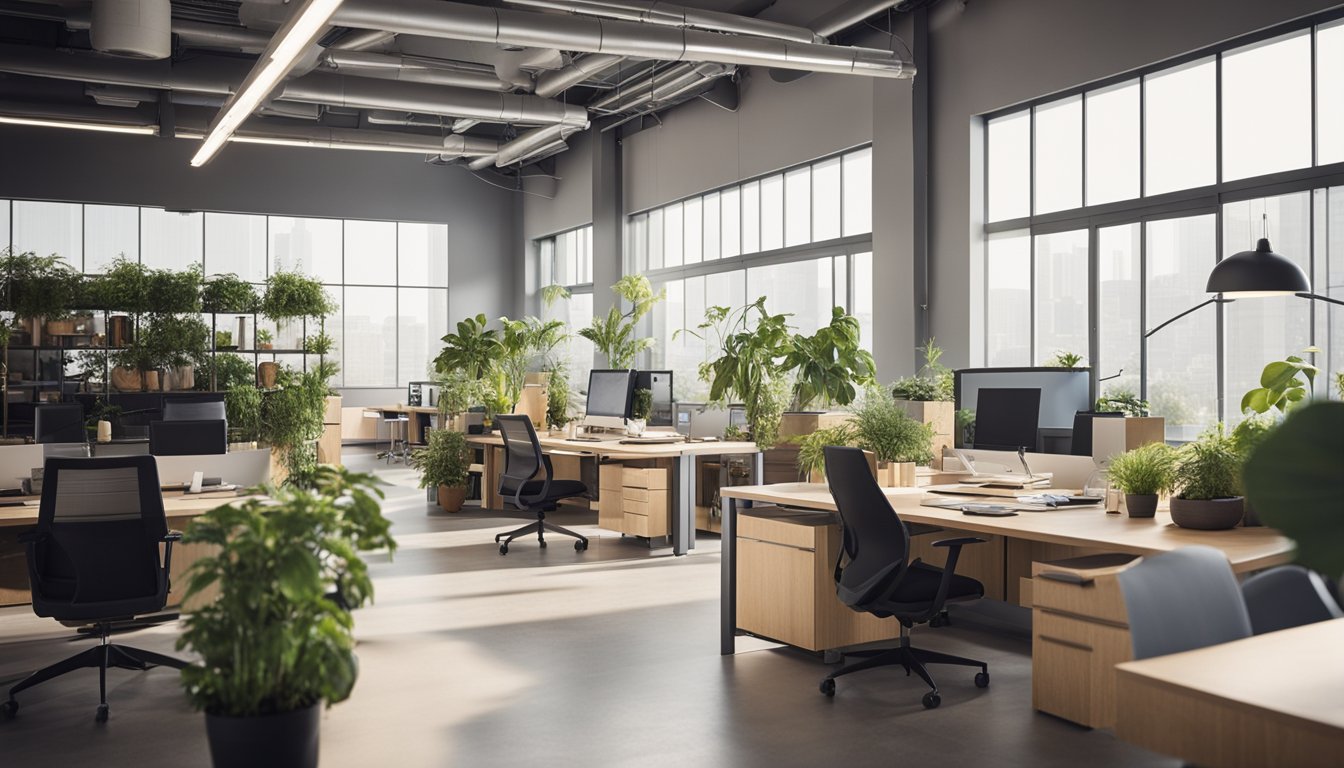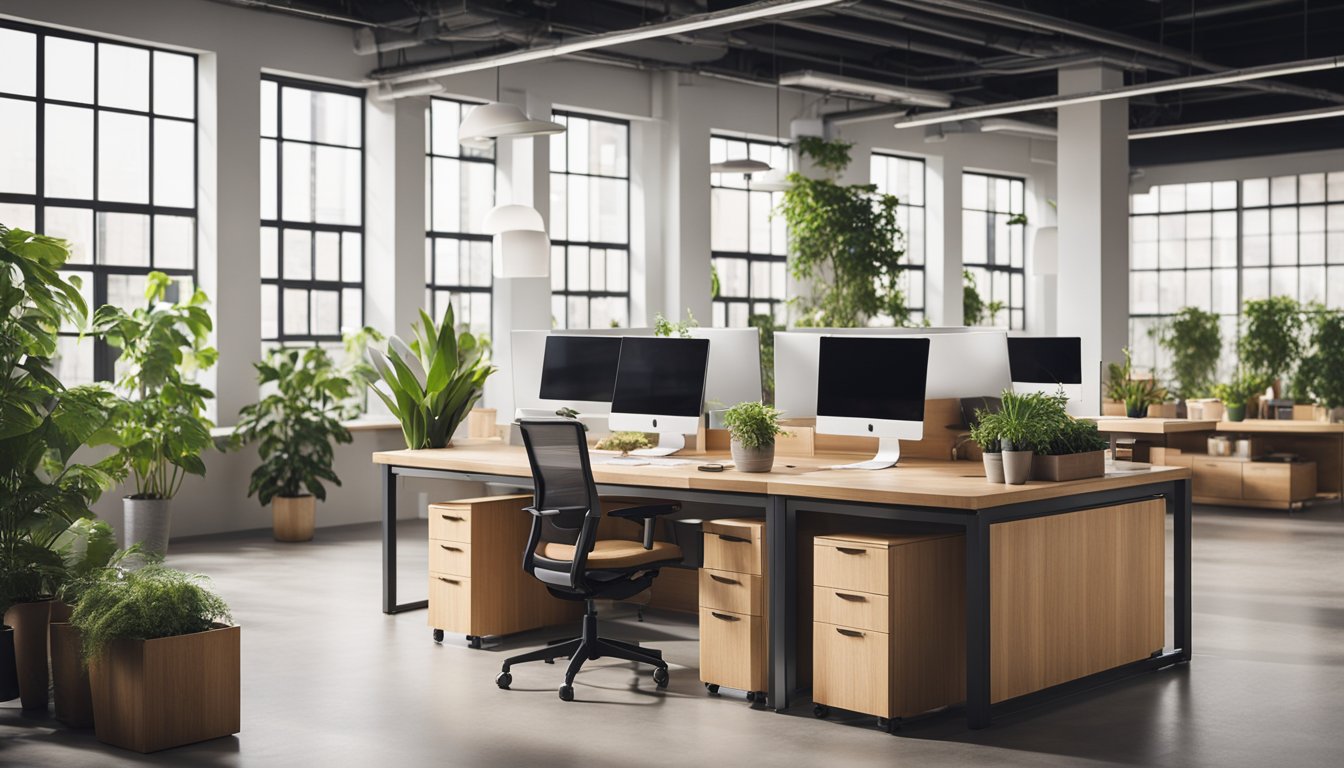Late updated: 16 Apr 2025 10:04
Written by: Amber Collins
Eco-Friendly Workspace Design Ideas For UK Offices: Embrace Sustainable Solutions
Creating a sustainable and eco-friendly workspace has become increasingly important for UK offices. By incorporating green design principles, we're not only reducing our carbon footprint but also enhancing the comfort and well-being of employees. An eco-friendly office design strategically blends sustainability with functionality, ensuring a healthier work environment while supporting global environmental goals.

As businesses move towards sustainability, there are countless strategies available to transform traditional workspaces into environmentally conscious centres. From incorporating energy-efficient lighting and using recycled materials to adding lush indoor plants, there are simple yet effective steps to achieve a green office environment. Eco-friendly workspaces not only contribute positively to the planet but also improve employee morale and productivity.
It's clear that embracing sustainable office design is beneficial for both the planet and our wellbeing. In this blog post, we'll explore a variety of innovative ideas and practical tips that can inspire and guide UK offices on their path to sustainability. We'll provide actionable insights that will enable you to enhance your office's green credentials effectively.
Key Takeaways
- Sustainable office design improves employee well-being and supports environmental goals.
- Practical strategies can transform any office into an eco-friendly workspace.
- Employee morale and productivity benefit from a greener work environment.
Key Principles of Sustainable Office Design

Creating a green office involves strategic use of natural light, embedding sustainable materials, and designing flexible spaces. These elements contribute to a reduced ecological footprint.
Incorporating Natural Light and Greenery
Optimising natural light in our workspaces can significantly reduce our dependence on artificial lighting, enhancing energy efficiency. Large windows, skylights, and open-plan layouts enable light diffusion throughout the office. Green walls and plant installations not only purify the air but also elevate the aesthetic of the workspace. By integrating green spaces, we create an inviting and productive atmosphere that boosts employee well-being and reduces stress, contributing to an overall healthier work environment. In implementing these solutions, we harness the power of natural elements to create eco-friendly offices that respect the environment.
Using Sustainable Materials and Technologies
Using materials with low environmental impacts is central to sustainable office design. Implementing products made from recycled or locally sourced materials can significantly lower our ecological footprint. Energy-efficient technologies, such as LED lighting and smart thermostats, contribute to creating a more sustainable and adaptable office environment. By prioritising devices that offer high performance with minimal energy consumption, we help conserve resources. Technology solutions that regulate energy use can further diminish our environmental impact. This focus on sustainable practices and materials makes our workspaces both innovative and responsible, aligning our operations with the demands of an evolving world.
Flexibility and Multifunctional Spaces
Modern offices benefit greatly from adaptable and multifunctional spaces. By incorporating movable partitions and versatile furniture, we allow the configuration of areas to shift in response to varying needs. This flexible design enables efficient use of space, accommodating both collaborative and individual work settings. As business dynamics shift, easily reconfigurable spaces allow us to respond quickly without the need for significant changes to infrastructure. Such adaptability not only enhances operational efficiency but also extends the usability period of our office setups, supporting long-term sustainability. The focus on flexibility ensures that our offices can evolve along with our needs, promoting a dynamic work environment.
Strategies for Enhancing Employee Well-being

In creating healthier workplaces, we focus on ergonomic furniture, the influence of colours and brand identity, and fostering collaboration to ensure employee well-being is prioritised effectively.
Ergonomic and Comfort-Driven Furniture
Choosing ergonomic furniture is essential for supporting employee posture and reducing strain. Height-adjustable desks, ergonomic chairs, and comfortable sofas contribute to physical health, ensuring employees can work efficiently.
We use furniture that adapts to various working styles, promoting comfort and flexibility throughout the workday. Ergonomically designed seating not only boosts well-being but also helps to enhance concentration and productivity. Our commitment to quality, comfort, and durability means employees benefit from a workspace that supports them physically and mentally.
Colours and Brand Identity in Design
The colours used in an office impact mood and productivity. For instance, blue is associated with calmness and focus, while green is known for its soothing effects. Our choice of colours reflects the company's brand identity, reinforcing a consistent visual message.
By incorporating brand colours, we create a cohesive environment that aligns with company values and identity. This approach not only strengthens brand recognition but also enhances employee engagement. The strategic use of colours positively influences job satisfaction and motivation by fostering an environment that employees feel personally connected to.
Promoting Collaboration and Creativity
Encouraging collaboration and creativity is vital for a dynamic workplace. Open-plan office designs with dedicated breakout spaces support team interactions. By integrating collaborative areas, we provide opportunities for spontaneous discussions and brainstorming sessions.
These spaces inspire innovation by combining informal settings with creative stimuli. Comfortable seating and writable surfaces cater to both individual and group work, fostering an environment where creative ideas can flourish. By prioritising an atmosphere that encourages interaction, we enhance employee well-being while driving collective innovation and satisfaction.
Frequently Asked Questions

Incorporating eco-friendly design features in UK offices can enhance sustainability and efficiency. From cost-effective strategies to innovative ideas, there are numerous approaches to creating an environmentally conscious workspace.
How can small UK offices implement eco-friendly design features?
Small UK offices can make significant changes with minimal investment. Using recycled or renewable materials like bamboo or reclaimed wood can create a sustainable environment. Prioritising natural light and energy-efficient lighting fixtures can reduce the carbon footprint, contributing to an eco-friendlier space.
What are some cost-effective strategies for designing sustainable office spaces in the UK?
Cost-saving strategies include utilising digital platforms for communication to reduce paper usage. Installing low-VOC paints and energy-efficient lighting can slash electricity costs and improve indoor air quality. By making small changes, offices can maintain an eco-friendly design without overspending.
Can you provide a case study on successful sustainable office design?
An inspiring case is the K2 Space office in London, showcasing sustainable practices with a focus on renewable materials and energy-efficient solutions. Their strategy includes maximising natural light and utilising digital tools to decrease their environmental impact.
What innovative ideas can make an office environment more eco-conscious?
Innovative approaches include integrating live plant walls to improve air quality and create a calming environment. Additionally, offices can use smart thermostats and automated systems to optimise energy use. Such measures help to foster a modern, eco-conscious environment.
What are the key considerations for creating a sustainable home office?
When designing a home office, select furniture made from sustainable materials to minimise environmental impact. Position the office space to maximise natural light, reducing reliance on artificial sources. Energy-efficient electronics and mindful paper use are fundamental elements of a green home office.
What are some effective ways to incorporate green principles into home office design?
Emphasise sustainability by choosing furniture that promotes long-term use and adaptability. Opt for second-hand or recycled items where possible. Incorporating plants can offer numerous benefits, such as improved air quality and stress reduction, creating a harmonious and productive workspace.
